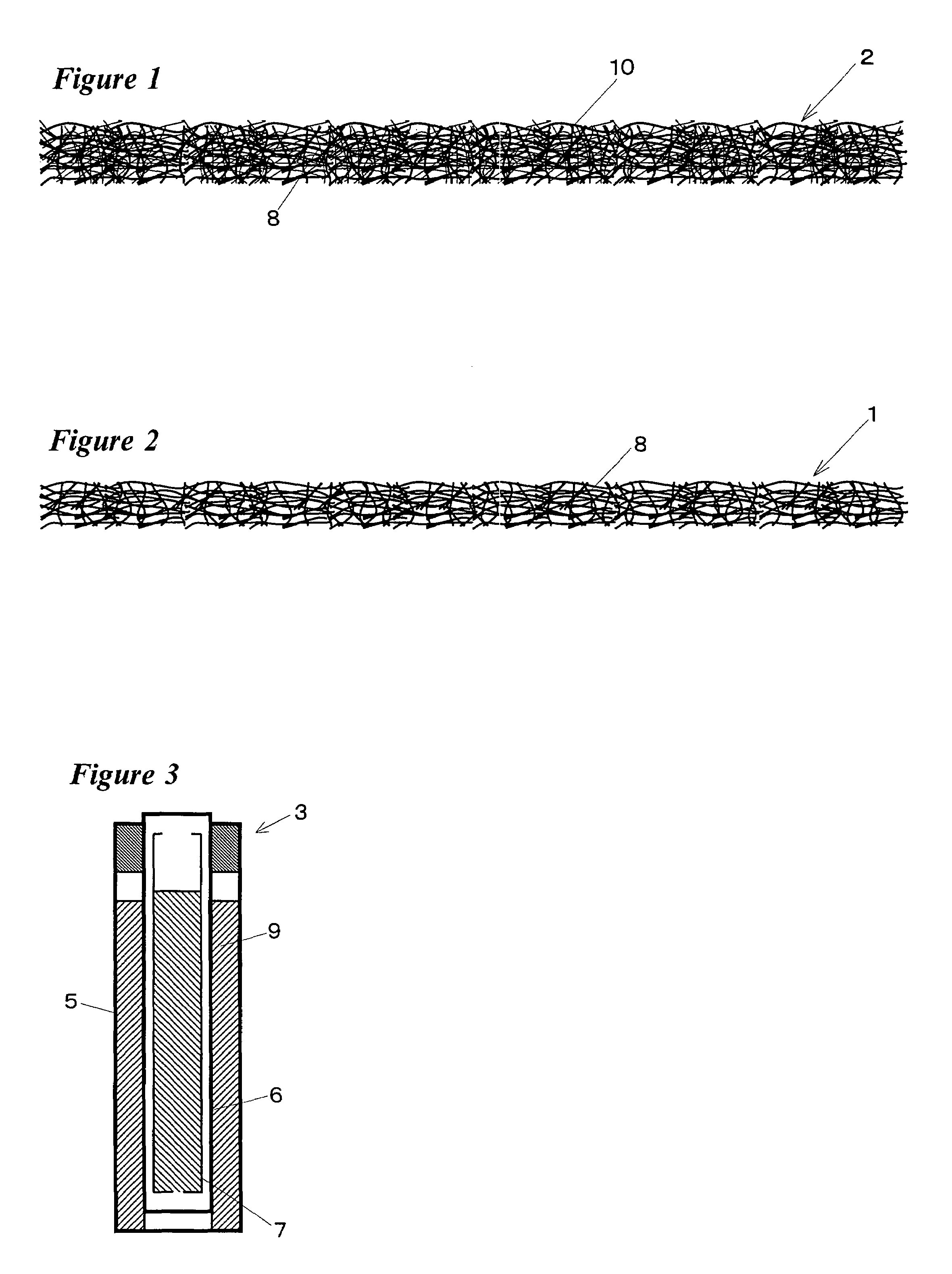Method for manufacturing an electric conductor for electrodes
a technology of electric conductor and electrode, which is applied in the manufacture of electrode systems, electric discharge tubes/lamps, cell components, etc., can solve the problems of insufficient improvement of performance and limitations of pan carbon fiber on cell performance improvement, and achieves improved remarkably generating efficiency of cells, reduced felt density, and increased volume of pores
- Summary
- Abstract
- Description
- Claims
- Application Information
AI Technical Summary
Benefits of technology
Problems solved by technology
Method used
Image
Examples
example 2
[0040]With the flame-resistant PAN fiber 8 applied in Example 1, there was mixed 10% in weight of polypropylene staple having a fineness of 7.7 dtex and 32 mm in length to form a lap by carding with a well-known carder. Suitable number of the lap thus obtained was layered and then a felt precursor 2 was prepared by needle-punching from one side thereof. The felt precursor 2 has a density of 0.148 g / cm3 and a degree of fiber orientation of 38%.
[0041]The felt precursor 2 was also baked at about 1600° C. to carbonize the flame-resistant PAN fiber 8 and incinerate the polypropylene staple. As this result, solid of the polypropylene staple was almost transpired and thereby the felt 2 was voided of the staple to yield a felt-type conductor 1 for electrodes. A density of the electric conductor 1 was diminished to 0.099 g / cm3. In the conductor 1, the felt density thereof lowered and pores thereof increased as compared with a normal felt made of a carbon fiber. When the conductor 1 was appli...
example 3
[0042]With the flame-resistant PAN fiber 8 applied in Example 1, there was mixed 5% in weight of polypropylene staple having a fineness of 4.4 dtex and 30 mm in length. By the same treatment as Example 1, there was prepared a felt precursor 2 having a density of 0.154 g / cm3 and a degree of fiber orientation of 33%.
[0043]The felt precursor 2 was baked to carbonize the flame-resistant PAN fiber 8 and incinerate the polypropylene staple. As this result, solid of the polypropylene staple was almost transpired and thereby the felt 2 was voided of the staple to yield a felt-type conductor 1. A density of the electric conductor 1 was 0.101 g / cm3. In the conductor 1, the felt density thereof lowered and pores thereof increased as compared with a normal felt made of a carbon fiber. When the conductor 1 was applied to sodium-sulfur cell, it held much melted sulfur and generating efficiency of sodium-sulfur cell was improved.
example 4
[0044]With the flame-resistant PAN fiber 8 applied in Example 1, there was mixed 5% in weight of polyester fiber having a fineness of 6.6 dtex and 38 mm in length, instead of polypropylene staple. By the same treatment as Example 1, there was prepared a felt precursor 2 having a density of 0.142 g / cm3 and a degree of fiber orientation of 31%.
[0045]The felt precursor 2 was baked to carbonize the flame-resistant PAN fiber 8 and incinerate the polyester fiber. As this result, solid of the polyester fiber was almost transpired and thereby the felt 2 was voided of the polyester fiber to yield a felt-type conductor 1 for electrodes. A density of the electric conductor 1 was 0.095 g / cm3. In the conductor 1, the felt density thereof lowered and pores thereof increased as compared with a normal felt made of a carbon fiber. When the conductor 1 was applied to sodium-sulfur cell, it held much melted sulfur and generating efficiency of sodium-sulfur cell was improved.
PUM
| Property | Measurement | Unit |
|---|---|---|
| length | aaaaa | aaaaa |
| density | aaaaa | aaaaa |
| electric resistance | aaaaa | aaaaa |
Abstract
Description
Claims
Application Information
 Login to View More
Login to View More - R&D
- Intellectual Property
- Life Sciences
- Materials
- Tech Scout
- Unparalleled Data Quality
- Higher Quality Content
- 60% Fewer Hallucinations
Browse by: Latest US Patents, China's latest patents, Technical Efficacy Thesaurus, Application Domain, Technology Topic, Popular Technical Reports.
© 2025 PatSnap. All rights reserved.Legal|Privacy policy|Modern Slavery Act Transparency Statement|Sitemap|About US| Contact US: help@patsnap.com

